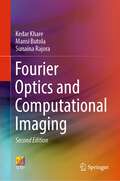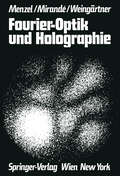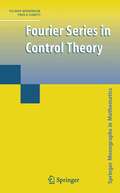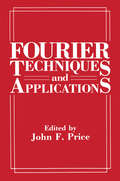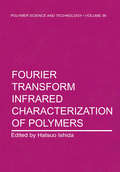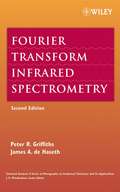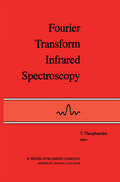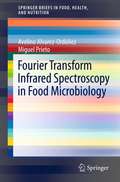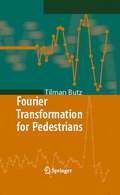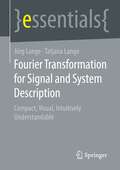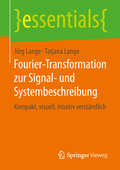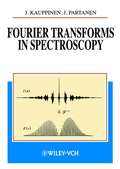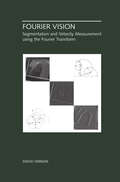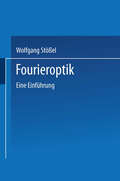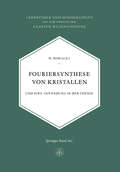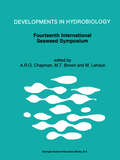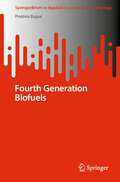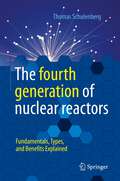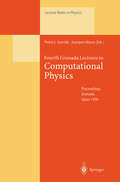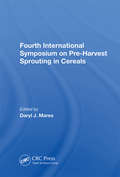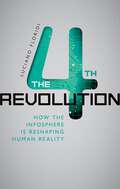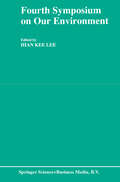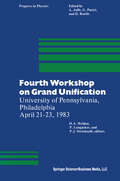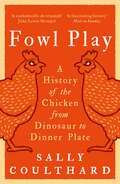- Table View
- List View
Fourier Optics and Computational Imaging
by Kedar Khare Mansi Butola Sunaina RajoraThe book is designed to serve as a textbook for advanced undergraduate and graduate students enrolled in physics and electronics and communication engineering and mathematics. The book provides an introduction to Fourier optics in light of new developments in the area of computational imaging over the last couple of decades. There is an in-depth discussion of mathematical methods such as Fourier analysis, linear systems theory, random processes, and optimization-based image reconstruction techniques. These techniques are very much essential for a better understanding of the working of computational imaging systems. It discusses topics in Fourier optics, e.g., diffraction phenomena, coherent and incoherent imaging systems, and some aspects of coherence theory. These concepts are then used to describe several system ideas that combine optical hardware design and image reconstruction algorithms, such as digital holography, iterative phase retrieval, super-resolution imaging, point spread function engineering for enhanced depth-of-focus, projection-based imaging, single-pixel or ghost imaging, etc. The topics covered in this book can provide an elementary introduction to the exciting area of computational imaging for students who may wish to work with imaging systems in their future careers.
Fourier Series in Control Theory (Springer Monographs in Mathematics)
by Vilmos Komornik Paola LoretiThis book is the first serious attempt to gather all of the available theory of "nonharmonic Fourier series" in one place, combining published results with new results by the authors.
Fourier Techniques and Applications
by John F. PriceThe first systematic methods of Fourier analysis date from the early eighteenth century with the work of Joseph Fourier on the problem of the flow of heat. (A brief history is contained in the first paper.) Given the initial tempera ture at all points of a region, the problem was to determine the changes in the temperature distribution over time. Understanding and predicting these changes was important in such areas as the handling of metals and the determination of geological and atmospheric temperatures. Briefly, Fourier noticed that the solution of the heat diffusion problem was simple if the initial temperature dis tribution was sinusoidal. He then asserted that any distri bution can be decomposed into a sum of sinusoids, these being the harmonics of the original function. This meant that the general solution could now be obtained by summing the solu tions of the component sinusoidal problems. This remarkable ability of the series of sinusoids to describe all "reasonable" functions, the sine qua non of Fourier analysis and synthesis, has led to the routine use of the methods originating with Fourier in a great diversity of areas - astrophysics, computing, economics, electrical engineering, geophysics, information theory, medical engineering, optics, petroleum and mineral exploration, quan tum physics and spectroscopy, to name a few.
Fourier Transform Infrared Characterization of Polymers (Polymer Science and Technology Series #36)
by H. IshidaThis book contains the proceedings of the Symposium on FT-IR Characterization of Polymers, which was held under the auspices of the Division of Polymer Chemistry, American Chemical Society (ACS) during the annual ACS meeting in Philadelphia, August, 1984. The content of each paper has been substantially extended from the papers presented during the conference. Due to the accidental, irrecoverable loss of the entire contents of the book by the computer system used for editorial purposes, the publication of this book has been delayed more than one year over the initial scheduled date. It has been a continuous, frustrating experience for the editor as well as for the authors. An extended Murphy's law, -anything can go wrong goes multiply wrong- has been demonstrated in editor's office. It necessitated, otherwise unnecessary, repeated proof reading during which time the editor had valuable experience ~n familiarizing himself with each paper much more than usual. The papers in this book are state-of-the-art even after such a delay. It is the authors pride and integrity toward the quality of each paper that makes the value of this book long lasting, while responsibility of the loss of any timeliness rests at the editor's hand. For the purpose of official records, submission and acceptance dates must be stated. All papers had been submitted by September, 1984, and had been accepted for publication by November, 1984, after the critical review processes.
Fourier Transform Infrared Spectrometry (Chemical Analysis: A Series of Monographs on Analytical Chemistry and Its Applications #171)
by Peter R. Griffiths James A. De HasethA bestselling classic reference, now expanded and updated to cover the latest instrumentation, methods, and applications The Second Edition of Fourier Transform Infrared Spectrometry brings this core reference up to date on the uses of FT-IR spectrometers today. The book starts with an in-depth description of the theory and current instrumentation of FT-IR spectrometry, with full chapters devoted to signal-to-noise ratio and photometric accuracy. Many diverse types of sampling techniques and data processing routines, most of which can be performed on even the less expensive instruments, are then described. Extensively updated, the Second Edition: * Discusses improvements in optical components * Features a full chapter on FT Raman Spectrometry * Contains new chapters that focus on different ways of measuring spectra by FT-IR spectrometry, including fourteen chapters on such techniques as microspectroscopy, internal and external reflection, and emission and photoacoustic spectrometry * Includes a new chapter introducing the theory of vibrational spectrometry * Organizes material according to sampling techniques Designed to help practitioners using FT-IR capitalize on the plethora of techniques for modern FT-IR spectrometry and plan their experimental procedures correctly, this is a practical, hands-on reference for chemists and analysts. It's also a great resource for students who need to understand the theory, instrumentation, and applications of FT-IR.
Fourier Transform Infrared Spectroscopy: Industrial Chemical and Biochemical Applications
by T. TheophanidesThis volume is a collection of contributions to the FT-IR Workshop held under the auspices of the Spectroscopy Society of Canada and organ ized by Professor Theophile Theophanides, Director of the Workshop. The gathering of leading spectroscopists and researchers at Gray Rocks to discuss .Fourier Transform Infrared Spectroscopy was the occasion of the 29th Annual Conference of the Spectroscopy Society of Canada. The plea sant surroundings of Gray Rocks, St-Jovite, Quebec, Canada contributed most positively to the success of the two-day Workshop held September 30, October 1, 1982. The preliminary program and the proceedings were distributed at the Workshop by Multiscience Publications Ltd. The publication of this volume provides the occasion to thank all the contributors for kindly accepting to lecture at the Workshop and for their collaboration. I thank Mr. AI. Dufresne for accepting to act as manager of the Workshop and Mrs. Susane Dufresne secretary of the Work shop for patiently contacting all the participants and for making the necessary arrangements of registration and accomodation.
Fourier Transform Infrared Spectroscopy in Food Microbiology (SpringerBriefs in Food, Health, and Nutrition)
by Avelino Alvarez-Ordóñez Miguel PrietoVibrational spectroscopy techniques, which have traditionally been used to provide non-destructive, rapid, and relevant information on microbial systematics, are useful for classification and identification. In conjunction with advanced chemometrics, infrared spectroscopy enables the biochemical signatures from microbiological structures to be extracted and analysed. In addition, a number of recent studies have shown that Fourier Transform Infrared (FT-IR) spectroscopy can help to understand the molecular basis of events, such as the adaptive tolerance responses expressed by bacteria when exposed to stress conditions in the environment, i.e. environments that cells confront in food and during food processing. The proposed Brief will discuss the published experimental techniques, data-processing algorithms, and approaches used in FT-IR spectroscopy to assist in the characterization and identification of microorganisms, to assess the mechanisms of bacterial inactivation by food processing technologies and antimicrobial compounds, to monitor the spore and membrane properties of foodborne pathogens in changing environments, to detect stress-injured microorganisms in food-related environments, to assess dynamic changes in bacterial populations, and to study bacterial tolerance responses.
Fourier Transformation for Pedestrians
by Tilman ButzCovers Fourier transformation and Fourier series with a particular emphasis on window functions. Written for students and practitioners who deal with Fourier transformation. Including many illustrations and easy-to-solve exercises Presents serious science in an amusing way
Fourier Transformation for Signal and System Description: Compact, Visual, Intuitively Understandable (essentials)
by Jörg Lange Tatjana LangeThe authors explain the Fourier transform and its technical applications, especially in signal and system theory. Based on their many years of teaching experience, they aim at helping especially STEM (science, technology, engineering, and mathematics) students as well as graduated professionals to better understand the subject. The authors also point out the importance of a deeper understanding, as all modern digital technologies such as sound and image recording and storage, radio and television, mobile telephony, signal transmission for the Internet, modern control techniques for vehicles or aircrafts – are largely based on the Fourier transform. The Authors Prof. Dr.-Ing. habil. Jörg Lange held a leading position in the development area of mobile communications in a large technology company. Prof. Dr.-Ing. Tatjana Lange taught control systems engineering at Merseburg University of Applied Sciences and is still active in research in the area of classification and cluster analysis.This Springer essential is a translation of the original German 1st edition essentials, Fourier-Transformation zur Signal- und Systembeschreibung by Jörg Lange and Tatjana Lange, published by Springer Fachmedien Wiesbaden GmbH, part of Springer Nature in 2019. The translation was done with the help of artificial intelligence (machine translation by the service DeepL.com). A subsequent human revision was done primarily in terms of content, so that the book will read stylistically differently from a conventional translation. Springer Nature works continuously to further the development of tools for the production of books and on the related technologies to support the authors.
Fourier-Transformation zur Signal- und Systembeschreibung: Kompakt, visuell, intuitiv verständlich (essentials)
by Jörg Lange Tatjana LangeDie Autoren erläutern die Fourier-Transformation und ihre technischen Anwendungen, insbesondere in der Signal- und Systemtheorie, dank ihrer langjährigen Erfahrungen sehr anschaulich. Sie möchten insbesondere MINT-Studenten und natürlich auch im Beruf stehenden Absolventen helfen, die Materie besser zu verstehen. Die Autoren zeigen zudem die Wichtigkeit eines vertieften Verständnisses auf, da alle modernen digitalen Techniken – wie Ton- und Bildaufzeichnung und Speicherung, Rundfunk und Fernsehen, Mobilfunk, Signalübertragung für das Internet, moderne Regelungstechniken für Fahrzeuge oder Flugzeuge – weitgehend auf den Erkenntnissen der Fourier-Transformation basieren.Die AutorenProf. Dr.-Ing. habil. Jörg Lange war in leitender Position im Entwicklungsbereich Mobilfunk in einem Technologiekonzern tätig, bevor er in Ruhestand ging.Prof. Dr.-Ing. Tatjana Lange lehrte vor ihrem Ruhestand Automatisierungstechnik an der Hochschule Merseburg und ist weiterhin in der Forschung aktiv.
Fourier Transforms in Spectroscopy
by Jyrki Kauppinen Jari PartanenThis modern approach to the subject is clearly and logically structured, and gives readers an understanding of the essence of Fourier transforms and their applications. All important aspects are included with respect to their use with optical spectroscopic data. Based on popular lectures, the authors provide the mathematical fundamentals and numerical applications which are essential in practical use. The main part of the book is dedicated to applications of FT in signal processing and spectroscopy, with IR and NIR, NMR and mass spectrometry dealt with both from a theoretical and practical point of view. Some aspects, linear prediction for example, are explained here thoroughly for the first time.
Fourier Vision: Segmentation and Velocity Measurement using the Fourier Transform (The Springer International Series in Engineering and Computer Science #623)
by David VernonFourier Vision provides a new treatment of figure-ground segmentation in scenes comprising transparent, translucent, or opaque objects. Exploiting the relative motion between figure and ground, this technique deals explicitly with the separation of additive signals and makes no assumptions about the spatial or spectral content of the images, with segmentation being carried out phasor by phasor in the Fourier domain. It works with several camera configurations, such as camera motion and short-baseline binocular stereo, and performs best on images with small velocities/displacements, typically one to ten pixels per frame. The book also addresses the use of Fourier techniques to estimate stereo disparity and optical flow. Numerous examples are provided throughout. Fourier Vision will be of value to researchers in image processing & computer vision and, especially, to those who have to deal with superimposed transparent or translucent objects. Researchers in application areas such as medical imaging and acoustic signal processing will also find this of interest.
Fouriersynthese von Kristallen: Und Ihre Anwendung in der Chemie (Lehrbücher und Monographien aus dem Gebiete der exakten Wissenschaften #6)
by W. NowackiFourteenth International Seaweed Symposium: Proceedings of the Fourteenth International Seaweed Symposium held in Brest, France, August 16–21, 1992 (Developments in Hydrobiology #85)
by A. R. O. Chapman Murray T. Brown Marc LahayeIndustrial seaweed use started in Brittany in the XVII century. Today, 700 species have been identified along 1000 km of shoreline, producing 10 million tons of biomass. In the Fourteenth International Seaweed Sumposium the latest developments in the area are discussed. The blending of molecular biology with traditional taxonomy is improving our understanding of phylogeny and species relationships among many of the important algae. A new generation of biologically-based management models is gradually incorporating field testing, concepts from ecological theory and principles from population biology. Prediction is being improved, and an appropriate balance is being struck between commercial exploitation and the preservation of wild seaweed resources. Cell and tissue culture of seaweeds is entering the mass-production phase. Field farming is now entering the large-scale production area. New, biologically active compounds are being described, obtained from algae, and new tools for the characterisation of phytocolloids are described. Microalgal blooms and toxins are also experiencing a flourish of new results.
Fourth Generation Biofuels (SpringerBriefs in Applied Sciences and Technology)
by Pratima BajpaiThis book examines the background of fourth-generation biofuel production, use of genetically modified microalgae for production of fourth-generation biofuels; cultivation and harvesting of genetically modified microalgae; residue from biofuel extraction; health and environmental concerns of fourth-generation biofuels; regulations on cultivation and processing of the genetically modified algae; carbon dioxide sequestration; water footprint and current status and key challenges. The topic caters to academic researchers and industrial experts, who work in the field of biofuels as source of alternative fuel to achieve environmental and economic sustainability.
The fourth generation of nuclear reactors: Fundamentals, Types, and Benefits Explained
by Thomas SchulenbergThis book is intended for readers who want to learn more about fourth-generation nuclear reactors without having to delve deeply into nuclear technology. These nuclear reactors are a number of visionary concepts for which special criteria have been set by the Generation IV International Forum with regard to safety, sustainability and economic efficiency. The book therefore describes, among other things, innovative water- and liquid-metal-cooled reactors, high-temperature and molten-salt reactors, and discusses their significance for the economy and society.The author imparts relevant basic knowledge of nuclear technology and then uses some illustrative examples to show what future opportunities this fourth generation of nuclear reactors will offer, but also what challenges will be associated with it.About the authorProf. Dr. -Ing. Thomas Schulenberg studied physics and mechanical engineering and received his doctorate in the field of sodium-cooled reactors. During his fourteen-year industrial career, he developed gas turbines for conventional power plants. Since 2000, Prof. Schulenberg was the head of the Institute for Nuclear and Energy Technology at the Karlsruhe Institute of Technology, where he lectured on conventional power plant technology as well as nuclear power plant technology. As a member of the steering committee for fourth-generation water-cooled reactors, he was actively involved in the Generation IV International Forum for many years.
Fourth Granada Lectures in Computational Physics: Proceedings of the 4th Granada Seminar on Computational Physics Held at Granada, Spain, 9–14 September 1996 (Lecture Notes in Physics #493)
by Pedro L. Garrido Joaquin MarroThe methods developed to deal with the computational aspects of physi cal problems are useful in an increasing number of situations, from chem istry, biology and geology to engineering, communications and economics. In fact, computational physics has evolved into a trans-disciplinary field now concerned with the creative use of computers in scientific research. More over, computational methods often help students to develop a deeper under standing of key concepts, and enhance their problem-solving abilities. There fore, computational physics is recognized as having an important educational value, and educators face the task of outlining appropriate curricula to take advantage of these unique features. This is an important motivation for the publication of the contents of the Seminar on Computational Physics which is held in Granada every two years. The seminar aims at bringing together small groups of students and active researchers on different aspects of computational physics. It is part of the doctoral programme of the University of Granada. The proceedings of the previous editions were published as II Granada Lectures in Computational Physics (World Scientific, Singapore 1993) and Third Granada Lectures in Computational Physics (Lecture Notes in Physics, vol. 448, Springer, Berlin 1995) by the same editors. The present book contains the invited lecture notes and a very brief account of contributions by participants at the 4th Granada Seminar on Computational Physics (Granada, Spain, 9-14 September 1996).
Fourth International Symposium On Pre-harvest Sprouting In Cereals
by Daryl MaresA major constraint on the production of high-quality grain around the world, pre-harvest sprouting in cereal crops causes substantial economic losses to producers and disrupts the processing, distribution, marketing, and storage of grain products. The solution to this problem must include a better understanding of the phenomenon, the development of
Fourth International Symposium On Pre-harvest Sprouting In Cereals
by Daryl MaresA major constraint on the production of high-quality grain around the world, pre-harvest sprouting in cereal crops causes substantial economic losses to producers and disrupts the processing, distribution, marketing, and storage of grain products. The solution to this problem must include a better understanding of the phenomenon, the development of
The Fourth Revolution: How the Infosphere is Reshaping Human Reality
by Luciano FloridiWho are we, and how do we relate to each other? Luciano Floridi, one of the leading figures in contemporary philosophy, argues that the explosive developments in Information and Communication Technologies (ICTs) is changing the answer to these fundamental human questions. As the boundaries between life online and offline break down, and we become seamlessly connected to each other and surrounded by smart, responsive objects, we are all becoming integrated into an "infosphere". Personas we adopt in social media, for example, feed into our 'real' lives so that we begin to live, as Floridi puts in, "onlife". Following those led by Copernicus, Darwin, and Freud, this metaphysical shift represents nothing less than a fourth revolution. "Onlife" defines more and more of our daily activity - the way we shop, work, learn, care for our health, entertain ourselves, conduct our relationships; the way we interact with the worlds of law, finance, and politics; even the way we conduct war. In every department of life, ICTs have become environmental forces which are creating and transforming our realities. How can we ensure that we shall reap their benefits? What are the implicit risks? Are our technologies going to enable and empower us, or constrain us? Floridi argues that we must expand our ecological and ethical approach to cover both natural and man-made realities, putting the 'e' in an environmentalism that can deal successfully with the new challenges posed by our digital technologies and information society.
Fourth Symposium on our Environment: Proceedings of the Fourth Symposium on Our Environment, held in Singapore, May 21–23, 1990
by Hian Kee Hian Kee LeeProceedings of the Fourth Symposium on Our Environment, held in Singapore, May 21-23, 1990
Fourth Workshop on Grand Unification: University of Pennsylvania, Philadelphia April 21–23, 1983 (Progress in Mathematical Physics #9)
by LANGACKER STEINHARDT WELDONIt has been sixteen years since the unification of electro Magnetism with the weak interactions was developed by Glashow, Salam, and Weinberg. Well before that proposal was fully confirmed by experiment, work began on unifying strong interactions with the electroweak. Now there is a growing effort to incorporate some theory of quantum gravity into the scheme. This enormous complex of theoreti cal and experimental efforts was the subject of the Fourth Workshop on Grand Unification held in Philadelphia and attended by over two hundred physicists. During the workshop, experimental and theoretical talks alternated as shown by the program summary on page 409. However, to display the logical scope of the workshop the proceedings are organized into five subject areas. Howard Georgi opened the workshop with a keynote address in which he reminds us of some of the simple properties of the particle spectrum that have not yet been understood. The first subject area, and also the largest, is proton decay and underground physics. This is introduced by ~Jill iam r1arciano' s review of the SU(5) predictions with particular attention paid to the theoretical uncertainties. Spokesmen for the major underground experiments present current results on proton decay, nn oscillations, and magnetic monopole flux: B. V. Sreekantan for the Kolar gold field experiment after 1. 9 years of operation, Earl Peterson for the Soudan detector after 0. 55 years, and Bruce Cortez for the rr'lB detector after 0. 22 years.
Fowl Play: A History of the Chicken from Dinosaur to Dinner Plate
by Sally CoulthardFrom dinosaur to dinner plate, Sally Coulthard tells the fascinating – and sometimes shocking – story of the domestic chicken.The chicken can fly only a few metres but – somehow – this unlikely evolutionary descendant of Tyrannosaurus Rex has conquered the world. Earth is now home to more than twenty billion chickens, at least ten times more than any other bird. For every human on the planet, there are three chickens.In Fowl Play, Sally Coulthard charts the chicken's fascinating journey from dinosaur to domestication to exploitation, exploring every aspect of the history of Gallus gallus domesticus: its importance to the ancient Egyptians, Greeks and Romans as food source and fighting bird; its symbolic roles in religion and folklore and metaphorical function in the language we use; its homely place as egg-providing companion on farms, smallholdings and in suburban back gardens; and its darker modern-day fate as battery bird raised to satisfy society's unquenchable addiction to wings and nuggets.Of all animals, chickens perhaps best represent the contradictory way we humans treat other species; both beloved pet and cheap commodity, symbol of a sustainable good life and brutalised object of factory farming. The chicken is also a bird we feel deeply familiar with and yet know very little about. As informative as it is entertaining, Fowl Play tells a remarkable tale of evolutionary change, epic global travel and ruthless exploitation – as well as of companionship, ingenuity and the folly of human nature.
